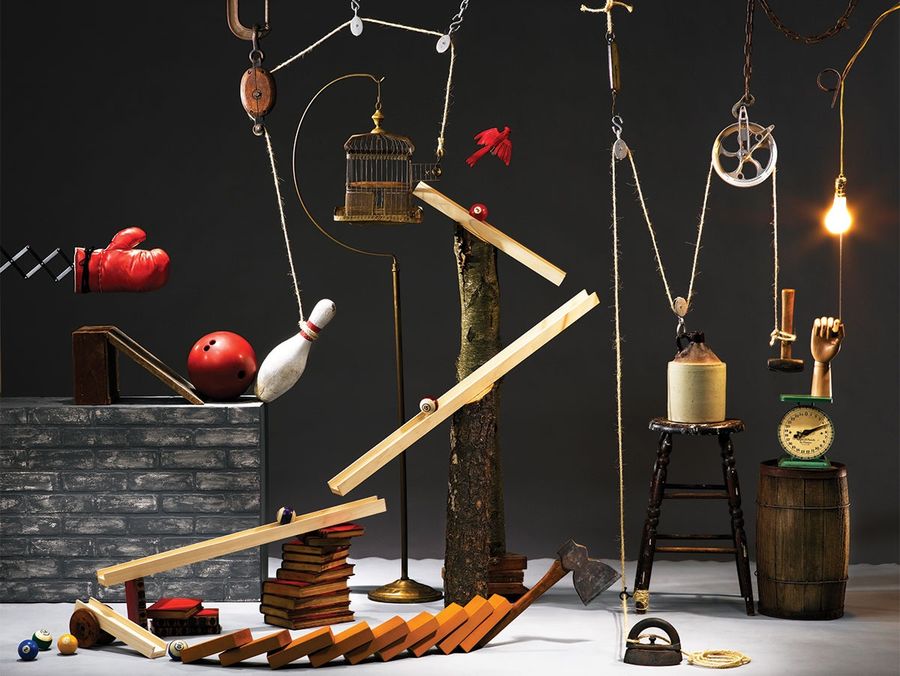In a world of efficiency and minimalism, Rube Goldberg machines are an intentional rebellion. These hilariously overcomplicated devices perform simple tasks using a complex chain reaction of moving parts, often involving balls rolling down ramps, swinging pendulums, falling dominoes, and even flying toast! 🍞🎯
But behind the whimsy lies real mechanical engineering, physics, and design thinking. Creating a great Rube Goldberg machine requires imagination, patience, and a deep understanding of how mechanical components interact. Let’s dive into the fun and fascinating world of these elaborate contraptions — and how you can design the perfect one yourself.
🤔 What Is a Rube Goldberg Machine?
A Rube Goldberg machine is a deliberately complex device that performs a very simple task in a highly convoluted and humorous way. Named after American cartoonist Rube Goldberg, who illustrated such absurd machines in his comics during the early 20th century, these devices are less about practicality and more about creativity and the celebration of inefficiency. 🎨🧠
Common tasks in these machines include:
-
Turning on a light switch 💡
-
Pouring cereal 🥣
-
Ringing a bell 🔔
-
Popping a balloon 🎈
They’re popular in science fairs, engineering challenges, advertisements, and viral YouTube videos. But despite the humor, building one teaches you real principles of physics, cause and effect, and mechanical design.
🛠️ Core Components of a Rube Goldberg Machine
To design an effective and entertaining Rube Goldberg machine, you need a variety of simple machines and mechanical components. Let’s look at the building blocks:
1️⃣ Levers
A lever is a rigid bar that rotates around a fulcrum. It’s used to lift or shift weight with minimal effort.
-
Example use: A falling ball hits one end of a seesaw, lifting the other end and triggering the next step. ⚖️
2️⃣ Inclined Planes
These are sloped surfaces that allow objects to roll or slide downward using gravity.
-
Example use: A marble rolls down a spiral ramp to hit a switch. 🌀
3️⃣ Pulleys and Ropes
Pulleys redirect force and motion. Multiple pulleys can even change the amount of force needed to lift objects.
-
Example use: A falling weight pulls a rope that lifts a spoon, dropping cereal into a bowl. 🥄🧵
4️⃣ Wheels and Axles
These can rotate to transfer energy or turn other components.
-
Example use: A spinning fan knocks over dominoes or triggers a lever. 🧭
5️⃣ Domino Chains
A line of upright dominoes (or anything similar) falling sequentially creates a reliable chain reaction.
-
Example use: The classic start or transition element in many machines. 🟫⬛⬜
6️⃣ Pendulums
A weight suspended from a pivot that swings when displaced — great for timed or dramatic actions.
-
Example use: A pendulum knocks over a glass or presses a button at just the right moment. ⛓️
🧪 The Physics Behind the Fun
Creating a Rube Goldberg machine involves multiple principles of physics:
-
Gravity: Most components rely on gravitational force to pull balls, weights, or liquids downward.
-
Potential and Kinetic Energy: A ball sitting on a ramp has potential energy; once released, it becomes kinetic energy.
-
Conservation of Momentum: Colliding objects (like dominoes or marbles) pass on their energy.
-
Friction and Resistance: Affects rolling and sliding objects; too much friction can stop your machine prematurely.
-
Timing and Synchronization: Components must operate in sequence, requiring careful timing and placement.
Designing a working machine is like orchestrating a mechanical symphony — everything has to hit its mark! 🎼⚙️
🧰 Steps to Design the Perfect Rube Goldberg Machine
Here’s a step-by-step guide to building your own:
🧠 1. Pick a Simple Final Task
Start by deciding what your machine will accomplish. Keep it simple — the more straightforward the final goal, the more creative the journey can be.
Examples:
-
Watering a plant 🌱
-
Cracking an egg 🥚
-
Popping a balloon 🎈
📐 2. Plan the Steps Backward
Work in reverse from the final step. This makes it easier to link all the events leading up to the main task.
🖊️ 3. Sketch Your Design
Use paper or software to sketch each stage. Draw where the marbles roll, the pulleys hang, and where each trigger connects.
🔍 4. Choose Your Materials
Use household items:
-
Marbles, dominoes, spoons, string, cardboard, toy cars, rubber bands, books, etc.
🧪 5. Build and Test Small Sections
Don’t build everything at once. Test each segment before linking it to others.
🔄 6. Link Sections Together
Once each part works, carefully join them. Watch for issues like timing delays, lack of momentum, or unexpected friction.
🛠️ 7. Fine-Tune and Add Flair!
Make it entertaining — add themes, colors, characters, or music. Rube Goldberg machines are meant to be fun, silly, and awe-inspiring!
🎮 Real-World Applications and Inspiration
While Rube Goldberg machines are whimsical, they have real-world parallels:
-
Automated factory lines use chain reactions of machines.
-
Logic gates and computer circuits follow a similar “if this, then that” process.
-
Mechanical engineering education uses these builds to teach causality and system design.
Inspiration for your machine:
-
OK Go’s music video: “This Too Shall Pass”
-
Honda’s “The Cog” ad: Uses real car parts in a giant Rube sequence
-
The MIT Museum: Hosts complex chain reaction events every year
-
“The Way Things Go” (1987 film): A mesmerizing continuous Rube-like sequence
🧠 Pro Tips for Rube Goldberg Mastery
-
Use marbles or balls — reliable and fast-moving components.
-
Make use of gravity to your advantage — go vertical!
-
Introduce delay elements like dominoes or pendulums.
-
Keep each part modular so you can troubleshoot.
-
Record your machine — it’s a great showpiece and helps identify timing issues.
🧾 Conclusion
Designing a Rube Goldberg machine is more than a fun science project — it’s a deep dive into physics, creativity, and mechanical engineering. It invites you to explore how cause and effect work, challenges your problem-solving skills, and rewards you with the sheer joy of watching your crazy contraption actually work. 😄🎉
Whether you’re a student, a maker, or just someone who loves creative challenges, building a Rube Goldberg machine will stretch your imagination and sharpen your understanding of how things move, fall, twist, and trigger. So gather your gears, pulleys, and patience — and let the fun begin!


